#mahler
Text
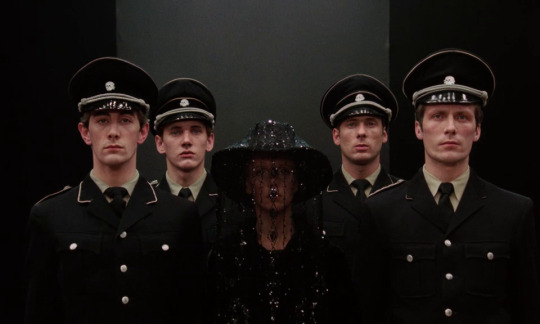
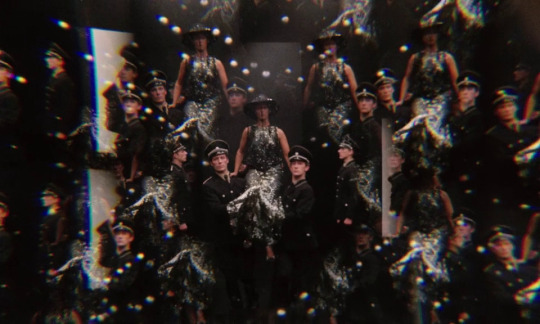
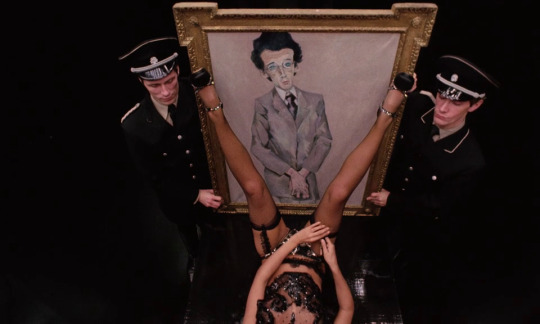

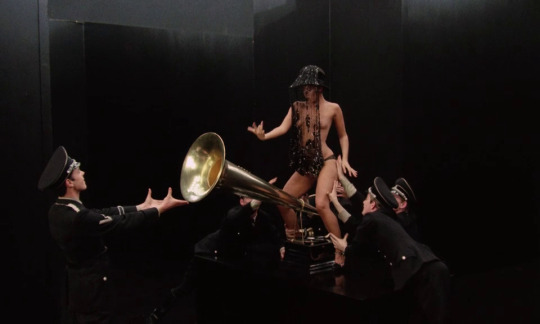
Ken Russell - Mahler (1974)
245 notes
·
View notes
Text


50 composers
#bach#mozart#beethoven#haydn#handel#paganini#schubert#mendelssohn#chopin#schumann#liszt#brahms#strauss#tchaikovsky#dvorak#elgar#mahler#debussy#rachmaninoff#stravinsky#ravel#gershwin#shostakovich#bernsterin
168 notes
·
View notes
Text
everyone shut up this is ACTUALLY what fans of different composers are like
Mahlerians are PROUD TO BE ABSOLUTELY INSUFFERABLE DRAMA QUEENS, THE LIKES OF WHICH EVEN THE WAGNER CULT COULD NEVER SO MUCH AS ASPIRE TO BE. WE ARE ONE WITH THE UNYIELDING EBB AND FLOW OF THE BOUNDLESS UNIVERSE, DAMN IT ALL!
Shostakovich fans are like Mahler fans except they actually understand what sarcasm is. We also all really like the Muppets for some reason. Most of us own cats and likely have at least one mental illness.
Liszt fans are either tweenagers who love anime or salty old pianists who know a disturbing amount about music theory. These two factions are constantly at war.
Copland fans are either very, very far right or very, very far left. Either way, neither side actually listens to all of Copland's repertoire.
Tchaikovsky fans are either Russian grandmas or LGBT orchestra kids on Tiktok. Either those or the one noob who heard there were cannons once.
Wagner fans. Yes, there are the cringey neo-Nazi Wagnerians, but anti-Nazi Wagnerians are a whole new level of chaotic good. They spend their time dreaming up the most disastrous, chaotic Ring productions possible, with the sole purpose of making Richard Wagner's entire family simultaneously spin in their graves. They take "death of the author" to a whole new level and constantly run on nothing but 100% pure spite. You want a Wagnerian who would beat up Wagner in a Denny's parking lot on your side.
Prokofiev fans will unironically say "ackshually...". That's it.
Dvorak fans are homeschool kids. They're either soul-crushingly innocent or devastatingly horny.
Sousa fans are just high school band directors who try to convince themselves they like Sousa to get through the semester.
Joplin fans constantly argue over whether Joplin's music should be played twice as quickly or twice as slowly than it's actually written. Also sick of hearing about Janis.
Chopin fans are exactly like Liszt fans, except there are 20% more "uwu softboi flowercrown" edits of Chopin than Liszt floating around on Instagram and Tumblr.
Holst fans will drag you into an alleyway and beat you up with their bare hands if you so much as mention The Planets.
Bernstein fans are either horny theatre kids or communists, but it's more likely they're both at once. They are very opinionated about recordings, and express their approval of the ones they like by gyrating excessively to them. If you put a Bernstein fan, a Mahler fan, and a Shostakovich fan in one room, they will either topple a national government or have a threesome.
Ravel fans are inherently Wes Anderson fans. You can be friends with one for years without knowing a single thing about their personality.
Schoenberg fans are like Mahlerians but with worse memes.
Brahms fans are... I have never met a Brahms fan. I'm sure they exist, but I'm pretty sure my own taste in music scares them off.
Paganini fans are almost always TwoSet kids, particularly the ones who try to convince people that "classical music isn't boring because it's basically metal." If you tell them Paganini played viola, they will spontaneously combust.
Rachmaninov fans are ultimately really chill, but are often socially awkward. If you ask a Rachmaninov fan "how are you?", they will most likely respond with "you too."
Schumann fans are Mahlerians on medication.
Stravinsky fans think they're chaotic and unhinged and listen to the most obscure underground shit, but in all actuality they just decided to enter their edgy phase after a lifetime of being sheltered and forced to listen to nothing but Handel by their parents. Possibly homeschooled.
Ysaye fans are like Paganini fans, except they're depressed graduate music students with permanent calluses on their fingers.
Debussy fans go to art school, decide they don't like art school, but have been doing art school too long to turn back, so they can't get out of art school. They may be high on weed at any given moment.
Satie fans are just possessed vessels of Erik Satie. Death cannot hinder Erik Satie. Erik Satie will return to this mortal plane. Search your feelings. You are already Erik Satie.
#classical music#music#composer#composers#mahler#shostakovich#iszt#copland#tchaikovsky#richard wagner#prokofiev#dvorak#sousa#scott joplin#chopin#ysaye#schumann#stravinsky#debussy#satie
595 notes
·
View notes
Text
mahler speedrun!
Have you ever wanted to experience each Mahler symphony but you have somewhere to be within the next 13 hours?
I have compiled a "Mahler remix" with just a bite of each symphony, using only my absolute favorite part of every one, and it clocks in at about 45 minutes.
Recommended for those who don't care about order, structure, and musical sense. 👍
#I didn't include erde but I did include 10 🫡#you would not believe how carefully i curated this 🧍♂️#mahler#classical music#you jump from frere jaques funeral durge to the very end of mahler 2 its CRAAAAZY#the chord at the very end of 4.3 thats supposed to set you up for 4.4 but NAY NAY!!! YOU JUMP TO 5.2!
93 notes
·
View notes
Text

Honey visualizing clothing that might suit some acquaintances of hers.
---
Inspired by a store in Like a Dragon Gaiden that references some Fighting Vipers characters by name.
92 notes
·
View notes
Text


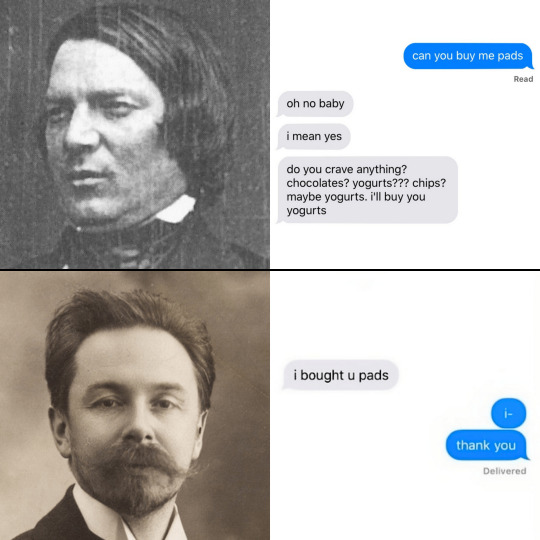


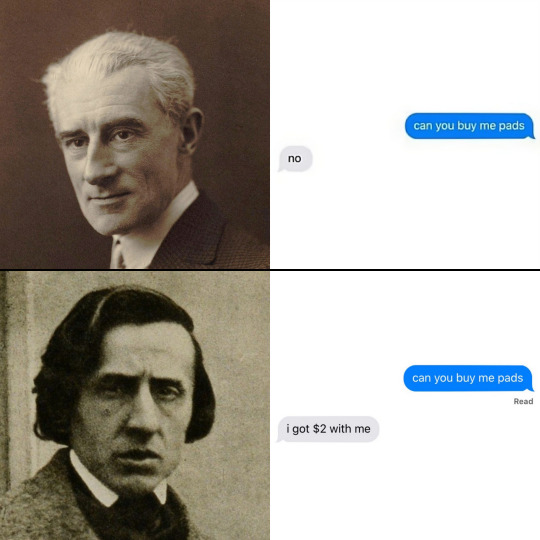
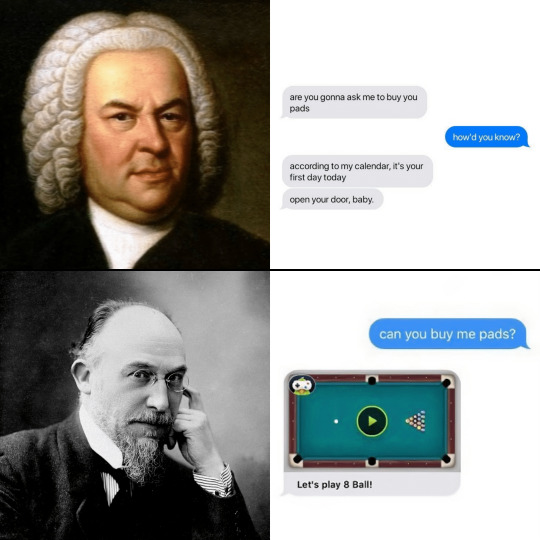

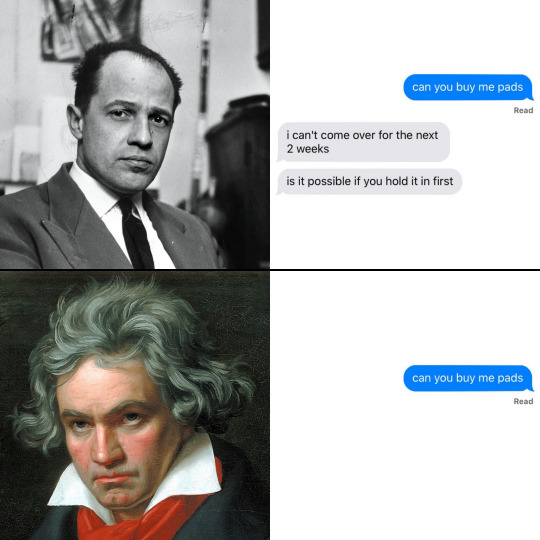

#berlioz#liszt#haydn#mahler#schumann#scriabin#rachmaninoff#mussorgsky#mozart#messiaen#ravel#chopin#bach#satie#boulez#beethoven#shostakovich#prokofiev#classical music#classical#classical composers#composers#classical music memes#can you buy me pads#memes
635 notes
·
View notes
Text
YouTube links: Mahler 2, Tchaikovsky 6
Comments:
Mahler 2
Have you ever wanted to feel like you're going to shake apart into a billion pieces if someone so much as looks at you. That's how I feel after listening to this beast. This symphony changed my life for real. It's famous for it's ending and for good reason!! It truly feels like your soul is getting blown up and steamrolled. Listening to it live was like getting peeled by god. It calls for 10 horns which is how you know it's going to fuck severely. It comes in 5 movements: good lord oh my god, hehe teehee, oh so that's why they call it the death shriek, crying on the floor for 5 minutes, and I Have Died. The part known as the "Death Shriek" is shown below! And if you're interested in learning more about the symphony, here's my favorite analysis website!
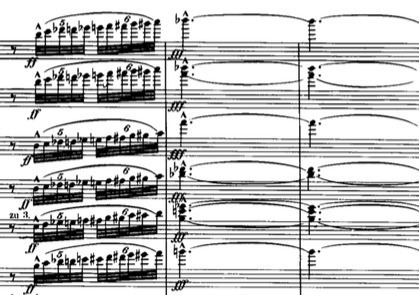
It's an everything in the universe piece and when I sang in the choir for it I think I actually ascended to a higher plane of existence for 15 minutes
I came across (imo) a good video giving a summarised background of Mahler 2, it’s called ‘Gustav Mahler - Symphony No. 2: Explained in 3 Minutes’ by orchestra of the music makers on YouTube
There is also a piano arrangement!

Tchaikovsky 6
Everyone bangs on about the 4th movement but it's the 3rd movement that really hits
tchaik 6 is what i would listen to if i had an hour to live
the 5/4 movement of the tchaik lives rent free in my mind and i think about it every day
It’s beyond gorgeous. The melodies soar, the orchestra swells, and you just need to lie down for a while after listening to it. It’s Romanticism at its zenith. You want to weep and sigh, and it’s impossible to listen to it without literally feeling something.

Symphony No. 6, titled “Pathétique”, was Tchaikovsky’s final symphony. It is an intensely emotional piece, and to many scholars demonstrates the emotional turmoil that characterized much of Tchaikovsky’s life. He died about a week after its premiere, a fact which leads many scholars to debate about whether the content of the piece itself reflects the possibility that he may have committed suicide. The title itself is often translated to mean “impassioned suffering”, although this was most likely a later addition by Modest and not actually part of Tchaikovsky’s vision. Given these facts, many scholars interpret this piece to be about death and suffering. However, this piece can also be seen to represent life and all its contrasting moments. This interpretation is more holistic and inclusive of all of the moments captured in this piece, and also serves to break down the common narrative of Tchaikovsky as a tragic figure.
More comments about Tchaikovsky 6 below the cut (length warning):
Scholarship surrounding Tchaikovsky’s music tends to focus heavily on the ways his confliction over his homoerotic desires appears in his writing. However, his personal letters reveal a much more balanced understanding of himself that goes beyond the common narrative. In one letter written to Modest describing a new relationship with another man, he writes: “I awoke today with a feeling of unknown happiness and with a complete absence of that emotional sobriety that used to make me repent in the morning for having gone too far the day before.” Many of the letters he wrote regarding his relationships demonstrate no shame and no anguish beyond what can be expected of a man living in a homophobic society. It is important to take this information into account when listening to a piece such as this one that has been discussed so frequently, and to understand it beyond the turmoil and strife that it is seen to represent. Like many of Tchaikovsky’s works, this symphony displays a range of human emotions. It is not only representative of tragedy and “impassioned suffering”; it is a depiction of what it is like to live. It is also interesting to note that this piece is used as a signifier of queer desire in the novel "Maurice" by E.M. Forster, a novel also notable for its radical portrayal of a queer man who gets a happy ending. Much to think about there.
The first movement begins with a lone bassoon soloist playing a plaintive minor melody, which later comes back in the strings. As the movement progresses, it grows in intensity and texture. More instruments are added, and the music becomes more frantic, building and building towards the dramatic trumpet fanfare. Throughout this piece, Tchaikovsky continues to make significant use of contrasting dynamics and melodies, reflecting the emotions he hopes to convey through the music. Dramatic, tumultuous sections are interspersed with pastoral woodwind melodies, and the angry brass fanfares give way to a quiet ending.
The second movement is reminiscent of a waltz, and uses the strings and woodwinds more than the brass to achieve its floating melodies. The dynamics ebb and flow to build tension, but this movement never reaches the same levels of anguish that the previous movement does. Tchaikovsky makes use of pizzicato in the strings to convey a lighter, more cheerful mood, and features the upper woodwinds prominently. He also repeats themes frequently, giving the audience something familiar to listen out for as the movement progresses.
The third movement begins with frantic energy in the strings and woodwinds. As more instruments join the rush of music, the underlying eight note accompaniment does not let up, continuing the vivacious beginning through the whole movement. Instruments pass the melodies between each other and engage in conversations across the orchestra. Like the first movement, the brass play a prominent role in creating dramatic climaxes in the music, as well as supporting the march-like conclusion. Conductor Myung-Whun Chung describes the deceptively dramatic ending as, “one of the greatest, most thrilling, but most empty of victories in musical history,” observing that this movement has the energetic finality of a final movement. The reversal of having the true finale be a slower movement represents a shift away from the “Beethovian model of light over darkness” common in most other symphonies of this time period.
As mentioned before, ending on a movement with a slow tempo was a significant shift away from the standard of the time. This innovation inspired many other future composers to use the same technique, most notably Mahler in his Ninth Symphony. The quiet beginning builds up towards a chaotic rush of fast runs throughout the orchestra, only to stop abruptly and continue in halting, cautious bursts of melody. The movement continues with this cycle of rushing up to a climax and backing away as the movement progresses. Tchaikovsky highlights the horns in this movement, giving them both angry, blaring notes which cut through the string melodies and the flowing, lyrical lines that are passed throughout the orchestra. As the piece ends, the instruments fall away until all that is left are steady repeated notes in the basses, bringing this lament of a movement to an understated close.
134 notes
·
View notes
Text
freehands of my favorite musical guys

#art#drawing#classical music#music#shostakovich#dmitri shostakovich#mahler#gustav mahler#ravel#maurice ravel#composers#classical composer
67 notes
·
View notes
Photo



A great reference, as Mahler’s Symphony #1 (the opening of the first movement) is the basis for the beginning of the original Star Trek theme.
687 notes
·
View notes
Text

context: every time in German class my friend knows something I don't, I go "you wot?" and they go "I learnt it from Rammstein"
further context: Mahler gives all his movements unnecessarily detailed titles
36 notes
·
View notes
Text



Ken Russell - Mahler (1974)
82 notes
·
View notes
Text
They’re actually the cutest 💜
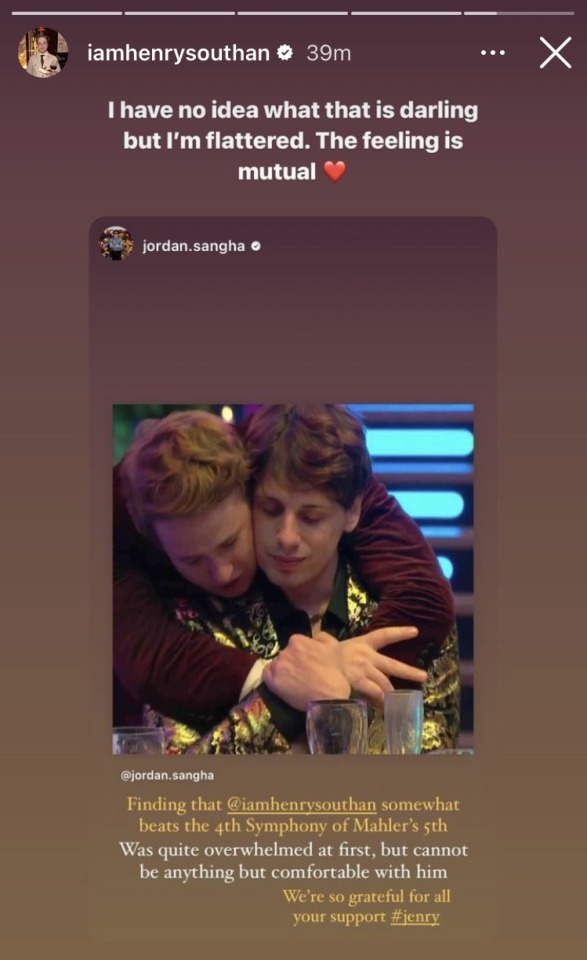
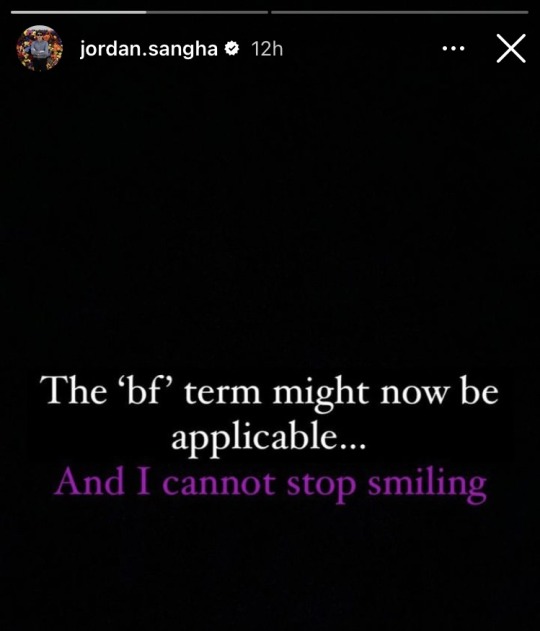


#i also do not know what the 4th symphony of mahler’s 5th is#but it is the most jordan compliment ever#they’re official !!#jordan sangha#henry southan#jenry#bbuk#bbuk 2023#big brother uk#mahler#cute couple#relationship goals#lgbtq positivity
29 notes
·
View notes
Text
if you read gustav mahler's letters, you'll find a surprising amount about his coffee maker
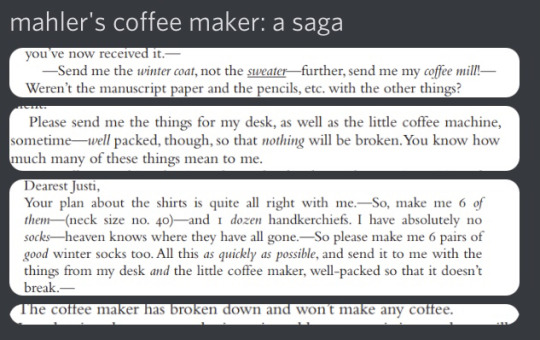
133 notes
·
View notes
Text
my dealer: got some straight gas 🔥😝 this strain is called “resurrection symphony” 😳 you’ll be zonked out of your gourd 💯
me: yeah whatever. I don’t feel shit.
90 minutes later: dude I swear I just struggled with the pain of living and came out of it with a renewed hope and awe for life after death
my buddy pacing: O Schmerz! Du Alldurchdringer! Dir bin ich entrungen!
#consider this before voting in the poll tuesday#does tchaik 6 have an offstage horn solo...?#mahler#classical music
127 notes
·
View notes
Text

Mahler and Katella, who have nothing in common other than being classical music enjoyers.
#And being able to bench a person too probably#katella the huntress#mahler#sonic#fighting vipers#mobius megamix#adokleart
65 notes
·
View notes
Text
'Forever'
"Exclusive enthusiasts of the new do not consider the quality of being able to be repeated, re-heard, rethought, reviewed - the Re value - of works.
This is what makes a work functional - becomes form - once it has crossed the threshold of raw astonishments.
To preserve wonder in habituation. This is a rare value in works. A woman whose repeated possession increases the lover's desire is an infinite value."
"Great artists did not strive to be noticed, but to be looked at for a long time - which is quite different. Astonishment lasts a short while; shocking is not a long-term goal. But to be recalled by memory, to establish a great desire to be seen again, that is to aim not at the moment of passing, but at the very depth of one's being. A work that calls people back to it is more powerful than one that merely provokes them. This is true in everything: as for myself, I classify books according to the need they have inspired in me to reread them, more or less."
Paul Valéry
VIDEO: 'Forever' ('Ewig'), Song of the Earth
Ballerina: Darcey Bussell
Music: Gustav Mahler
Choreography: Kenneth MacMillan
#of great art#heroine#artist#art#music#classical music#dance#ballet#gustav mahler#darcey bussell#ballerina#dancer#goddess#mahler#paul valery#forever#choreography#choreographer
19 notes
·
View notes